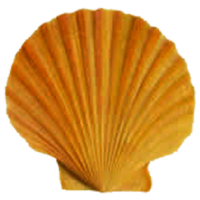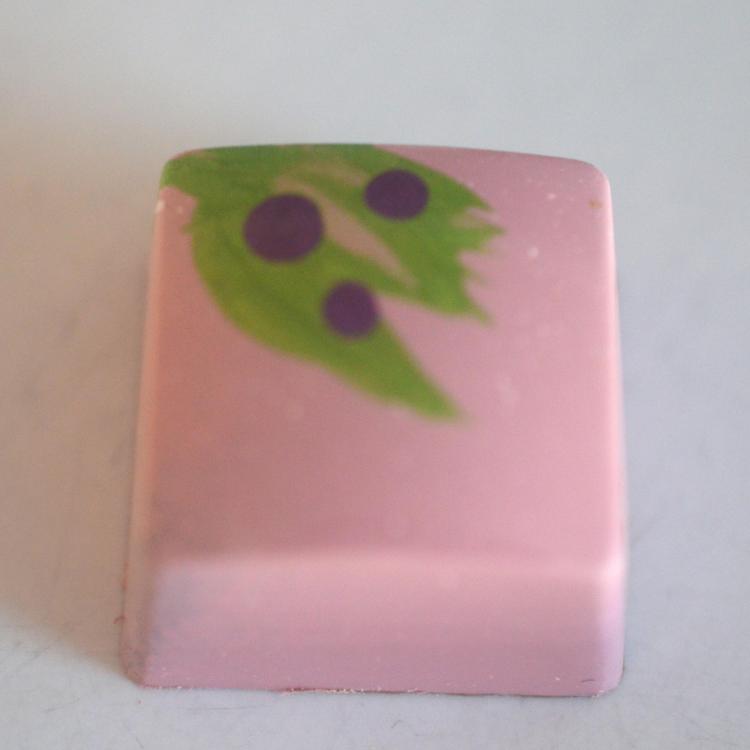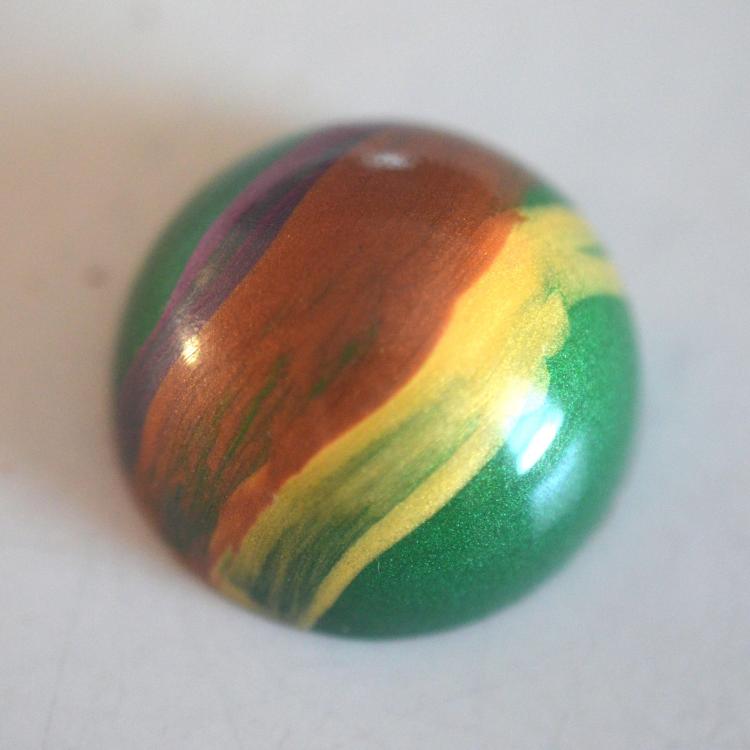-
Posts
2,412 -
Joined
-
Last visited
Contact Methods
-
Website URL
www.santiagochocolates.com
Profile Information
-
Location
Staunton, Virginia
Recent Profile Visitors
12,843 profile views
-
If I recall correctly, Kate Weiser uses the method of shipping her chocolates when frozen and uses special packaging to protect them. Especially during the upcoming holiday season, there is no guarantee as to how long a package may sit around, so some sort of serious protection needs to be used.
-

Molded and Filled Chocolates: Troubleshooting and Techniques
Jim D. replied to a topic in Pastry & Baking
I have tried using the heat gun for all chocolates and noticed no difference. I have tried it for just caramels to avoid leaking, and I wasn't sure it made a difference. I tried it with half-spheres (which often show the chocolate line), and I probably overdid it because the bonbons stuck in the mold and needed more than a little pounding on the counter (they usually pop right out). I'll give it a try with this difficult square mold. With using silk to temper, I keep the chocolate a full degree above the norm so as to get as much heat as possible to join the bottom to the rest of the shell. -

Molded and Filled Chocolates: Troubleshooting and Techniques
Jim D. replied to a topic in Pastry & Baking
I have had cocoa butter separate into plain CB and the color, but never with the CB liquid. -

Molded and Filled Chocolates: Troubleshooting and Techniques
Jim D. replied to a topic in Pastry & Baking
If the bonbon has a dark color, the seepage doesn't show so much, but with the rose color in the photo, the chocolate was really obvious. I scraped it off for a few of them. Fortunately these molds make 40 bonbons per mold, so I had lots of extras. But for Christmas production, this is not acceptable. My "solution" for Christmas: I'm painting flowers similar to the ones shown and then shelling in Dulcey--no airbrushing involved, thus seepage will be invisible. Strangely, the shallower version of this same mold had no seepage at all. Work flow: Since I work alone in a very limited space, I have to color all the molds, then shell, fill, and seal the dark chocolate ones, follow the same process with the milk. I think the problem occurs between shelling and sealing, and I don't see a solution to the time it takes to make the fillings (depending on the recipe, I can do 3-4 per day). So I think my "Dulcey solution" is the only thing I can do. As you suggest, if I could shell, fill, and seal in a short period of time, the seepage probably would not occur. I can't do the fade trick with color as I ordinarily use the Fuji sprayer, which does not allow for such subtlety. What I lose with the Fuji I gain in speed--and, most importantly, with the lack of clogging of the gun. If I preheat it in a heating pad and keep it warm with a heat gun, it does not clog. I have frequent clogging with my Grex. With your much larger production, I think you would love the Fuji. No, I don't use cups. I bought trays so that I could stop using cups. Separating cups is a job I need to avoid for sanity's sake. -
I should have added that the e-book showing the stripes design (and others as well) is available at https://www.tinepreferschocolate.dk/item/no-airbrush-needed-beautiful-designs-english-version. It's just US $22.
-
No, one color at a time is used. You can see more of the designs on Tine's Instagram page: https://www.instagram.com/p/DRAgznvDc_4/
-
Tine Forst has a keen eye for complementary colors. I wish she would produce a video (rather than just the ebook) showing this technique. I think it's all in the texture of the brush and the force used in moving the brush. Almost worth a trip to Denmark to watch the process. Ordering the fan brushes online is not terribly useful; purchasing them in an art store would be much better--if only one could find an art store these days.
-
-

Molded and Filled Chocolates: Troubleshooting and Techniques
Jim D. replied to a topic in Pastry & Baking
And, to follow up yet again, on my Turkish mold saga, here is the bonbon I made using the mold: And, for the plus and minus factors: I love the square shape. Decorating it has so many possibilities that don't work in a dome. And the bonbons come out of the mold very easily; I am assuming this is because the square is not completely flat but has a slight curve to it (Chef Rubber sells a smaller version, from the same manufacturer, and calls it a "slumped square"). The negative: Too many of the bonbons have that irritating line of chocolate that shows along the bottom of the finished item. The explanation that makes the most sense is that the chocolate contracts as it crystallizes and so allows the chocolate used to seal the mold to seep down the side, thus showing up on the finished product. It can be scraped off with a tiny knife, but what a pain! A question for the scientists among us: why would the creepage happen in this shape? Or why would it happen in some cavities and not all of them? These molds are not particularly shallow (the usual issue). I know it happens in half-spheres (and even a very famous U.S. chocolatier posts photos that show the problem). Kalle Jungstedt says the "solution" is to use white chocolate and a light-colored cocoa butter. These molds are also very large (8 rows x 5 rows), much larger than any other mold I have seen. They require a lot of wrist strength to hold when they are full. I suppose the advantage of having so many bonbons is that when the "chocolate creepage" happens, those bonbons can be put aside and not used. So, one of my "ideas that come in the night to the chocolatier": For Christmas I will cast the molds in Duicey and fill them with perhaps passion fruit ganache or perhaps apricot PDF plus almond giandiuja or ... ? -
That is one of her color combinations; there are many others. The "secret" is in the brushes. She uses fan brushes, applying colors with some pressure so that the fan spreads. I ordered fan brushes, but they were too flimsy to work. Tine Forst is very helpful, answering any questions sent to her (even, in my case, when I asked her more or less the same questions several months apart!). Here is my version, definitely not up to her results:
-
Chocolatier and author Tine Prefers Chocolate has an ebook on decorating without an airbrush. Her striped bonbon is beautiful; alas, my experiments have not equaled hers.
-
With chocolates, there is a thin layer of chocolate (called a foot or a chablon). Most experts say it should be untempered so as not to be so firm. Then the filling is spread on top of the chocolate. The chablon makes it easier to pick up each piece to be dipped and keeps it from sticking to the guitar so much. Some people add another layer of chocolate on top of the filling(s). As pastrygirl suggests, the biscuit layer may not be as crisp as it appears; it may be more like pie crust than a cookie. I would probably risk cutting something like that.
-
Watching the video, I can certainly see why you want to make something similar. You can see the difficulty of cutting the marshmallow--it has to be just the right texture for the wires to go through it (mostly) cleanly. The video's caption states that the layer is a biscuit. Just in case...somewhere on this forum @pastrygirl has posted a video showing how to replace a guitar wire. She helped me through my first (and so far only) guitar crisis.
-
I would not risk my guitar on a baked biscuit (if you ever had to replace a wire, you know what I mean). I also think cutting the biscuit risks having it break into bits. Instead I would make a "praliné" (as some people call it). This technique requires a bar mold. Bake the biscuits, grind them into crumbs, add some melted cocoa butter and whatever kind of chocolate that fits with the flavors in the bar. Pipe that into the bar mold on top of the other fillings. If your proportions are correct, the crisp layer will firm up. This way you have your desired layer without endangering the guitar, and you also get the flavor that was in the biscuit. If you don't want to use a mold, you can pour the crispy layer onto a flat surface and wait for just the right consistency to cut it into the same size as you want the finished product to be. I can send you a recipe showing the proportions for the crispy layer if you need that. I realize this is not exactly what you were aiming for, but it does avoid endangering wires.
-
Yes, that is a new bonbon for Greweling (or at least a new decoration). He has not been a huge fan of decorations, certainly not the elaborate ones that are all over Instagram and elsewhere in the past few years. I am interested that he would go for a third edition: I watched an interview with him that Tomric did in which Greweling expressed his reluctance to participate in the second edition--he said he was quite satisfied with the first one. I suppose what the publisher wants, the publisher gets. And we will all purchase the new one for "fear of missing out."













